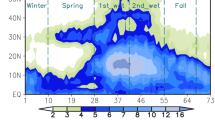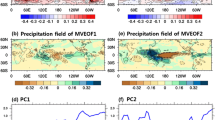Abstract
The effect of bias on control simulation is a significant issue for climate change modeling studies. We investigated the effect of the sea surface temperature (SST) bias in present day (0 ka) Atmosphere–Ocean Coupled General Circulation Model (AOGCM) simulations on simulations of the mid-Holocene (6 ka, i.e., 6,000 years before present) Asian monsoon enhancement. Because changes in ocean heat transport have a negligible effect on the 6 ka Asian monsoon (Ohgaito and Abe-Ouchi in Clim Dyn 29(1):39–50, 2007), we used an Atmospheric General Circulation Model (AGCM) rather than an AOGCM. Simulations using the AGCM coupled to a mixed layer ocean model (MLM) were conducted for 0 and for 6 ka with different ocean heat transport estimated from the climatological SST of the 0 ka simulations from nine Paleoclimate Modeling Intercomparison Project (PMIP) phase 2 (PMIP2) AOGCMs (henceforth “MA” is used to refer to experiments using the AGCM coupled with the MLM). No correlation between MA and the corresponding PMIP2 was seen in the 0 ka precipitation and it was not very strong for the 6 ka precipitation enhancement. Thus, the influences from the different AGCMs play a substantial role on the 0 ka precipitation and the 6 ka precipitation enhancement. The sensitivity experiments indicated that it was the pattern of the 0 ka SST bias which played a dominant role in the 0 ka precipitation and the 6 ka precipitation enhancement, not the difference in the mean value of the SST bias. The distributions of the 6 ka precipitation enhancements for the nine PMIP2 AOGCMs and nine MA experiments were compared. These showed that the effects of SST bias on 6 ka precipitation enhancement among the AOGCMs were not negligible. The effects of biases among the AGCMs were not negligible either, but of comparable size. That is, improvements in both the SST bias and the AGCM contribute to simulate better 6 ka monsoon.








Similar content being viewed by others
References
Braconnot P, Loutre MF, Dong B, Joussaume S, Valdes P (2002) How the simulated change in monsoon at 6 ka BP is related to the simulation of the modern climate: results from the Paleoclimate Modeling Intercomparison Project. Clim Dyn 19(2):107–121. doi:10.1007/s00382-001-0217-5
Braconnot P, Otto-Bliesner B, Harrison S, Joussaume S, Peterchmitt JY, Abe-Ouchi A, Crucifix M, Driesschaert E, Fichefet T, Hewitt CD, Kageyama M, Kitoh A, Loutre MF, Marti O, Merkel U, Ramstein G, Valdes P, Weber L, Yu Y, Zhao Y (2007) Results of PMIP2 coupled simulations of the Mid-Holocene and Last Glacial Maximum—Part 2: Feedbacks with emphasis on the location of the ITCZ and mid- and high latitudes heat budget. Clim Past 3(2):279–296
Douville H (2005) Limitations of time-slice experiments for predicting regional climate change over South Asia. Clim Dyn 24(4):373–391. doi:10.1007/s00382-004-0509-7
Gates WL (1992) AMIP: The Atmospheric Model Intercomparison Project. Bull Am Meteorol Soc 73(12):1962–1970
Giorgi F, Francisco R (2000) Evaluating uncertainties in the prediction of regional climate change. Geophys Res Lett 27(9):1295–1298. doi:10.1029/1999GL011016
Hewitt CD, Mitchell JFB (1997) Radiative forcing and response of a GCM to ice age boundary conditions: cloud feedback and climate sensitivity. Clim Dyn 13(11):821–834
K-1 Model Developers (2004) K-1 coupled model (MIROC) description. K-1 technical report, 1. In: Hasumi H, Emori S (eds) Center for Climate System Research, University of Tokyo, Japan, p 34
Kittel TGF, Giorgi F, Meehl GA (1998) Intercomparison of regional biases and doubled CO2-sensitivity of coupled atmosphere–ocean general circulation model experiments. Clim Dyn 14(1):1–15
Kripalani RH, Oh JH, Kulkarni A, Sabade SS, Chaudhari HS (2007) South Asian summer monsoon precipitation variability: coupled climate model simulations and projections under IPCC AR4. Theor Appl Climatol 90(3–4):133–159
Mitchell JFB, Wilson CA, Cunnington WM (1987) On CO2 climate sensitivity and model dependence of results. Quart J Royal Meteorol Soc 113(475):293–322
Ohgaito R, Abe-Ouchi A (2007) The role of ocean thermodynamics and dynamics in Asian summer monsoon changes during the mid-Holocene. Clim Dyn 29(1):39–50
Russell GL, Miller JR, Tsang LC (1985) Seasonal oceanic heat transports computed from an atmospheric model. Dyn At Oceans 9(3):253–271
Terray P, Delecluse P, Labattu S, Terray L (2003) Sea surface temperature associations with the late Indian summer monsoon. Clim Dyn 21(7–8):593–618
Xie PP, Arkin PA (1996) Analyses of global monthly precipitation using gauge observations, satellite estimates, and numerical model predictions. J Clim 9(4):840–858
Yoo SH, Yang S, Ho CH (2006) Variability of the Indian Ocean sea surface temperature and its impacts on Asian–Australian monsoon climate. J Geophys Res 111:D03108. doi: 10.1029/2005JD006001
Zhao Y, Braconnot P, Marti O, Harrison SP, Hewitt C, Kitoh A, Liu Z, Mikolajewicz U, Otto-Bliesner B, Weber SL (2005) A multi-model analysis of the role of the ocean on the African and Indian monsoon during the mid-Holocene. Clim Dyn 25(7–8):777–800
Zhu YL, Houghton DD (1996) The impact of Indian Ocean SST on the large-scale Asian summer monsoon and the hydrological cycle. Int J Clim 16(6):617–632
Acknowledgments
First of all, we would like to thank the MIROC model developers. We are most grateful to the PMIP modeling groups for providing their data for analysis, and to the Laboratoire des Sciences du Climat et de l’Environnement for collecting and archiving the model data. The PMIP2/MOTIF Data Archive is supported by CEA, CNRS, the EU project MOTIF (EVK2-CT-2002-00153) and the Programme National d’Etude de la Dynamique du Climat. Further information is available at http://pmip2.lsce.ipsl.fr/ and http://motif.lsce.ipsl.fr/. We also thank WL Chan for his help on proofreading. Finally, we would like to acknowledge the valuable comments from two reviewers whose suggestions have inspired us to improve this work.
Author information
Authors and Affiliations
Corresponding author
Rights and permissions
About this article
Cite this article
Ohgaito, R., Abe-Ouchi, A. The effect of sea surface temperature bias in the PMIP2 AOGCMs on mid-Holocene Asian monsoon enhancement. Clim Dyn 33, 975–983 (2009). https://doi.org/10.1007/s00382-009-0533-8
Received:
Accepted:
Published:
Issue Date:
DOI: https://doi.org/10.1007/s00382-009-0533-8




